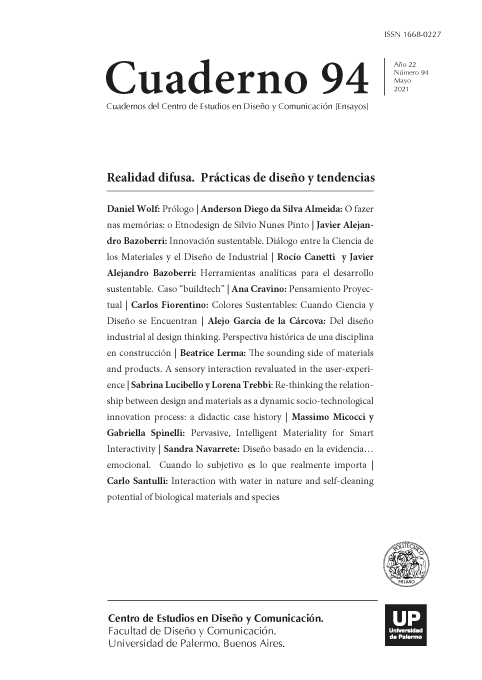Interaction with water in nature and self-cleaning potential of biological materials and species
Abstract
Self-cleaning is an important characteristics of many biological species, considerably investigated in the biomimetic literature, with the aim to offer it into innovative materials. To try to summarize the different properties of bio-inspired materials having self-cleaning effect, different modes of classification have been proposed. In particular, either a paradigmatic species is cited, for example “lotus effect”, “rose petal effect”, etc., or a physical property is mentioned, such as super-hydrophobicity, super-oleophobicity, etc. This work considers some different modes in which nature implements self-cleaning as a form of effective interaction with water, depending on the respective needs of the various species. With this aim, a sample of ten species, selected among those which have been more investigated in biomimetic literature, have been considered. An attempt of classification is then given, trying to offer information for the development of new materials inspired from nature offering self-cleaning properties in different conditions of application.
References
Autumn K, Gravish N (2008), Gecko adhesion: evolutionary nanotechnology, Phylosophical Transactions of the Royal Society A 366, pp. 1575–1590.
Ball P, (1999) Engineering shark skin and other solutions, Nature 400, 5 August 1999, pp. 507–509.
Bixler GD, Bhushan B, (2013) Fluid drag reduction with shark-skin riblet inspired microstructured surfaces, Advanced Functional Materials 23, pp. 4507–4528.
Bhushan B, Nosonovsky M, (2010) The rose petal effect and the modes of superhydrophobicity, Phylosophical Transactions of the Royal Society A 368 (1929), 28 October 2010, pp. 4713-4728.
Cheng Q, Li M, Zheng Y, Su B, Wang S, Jiang L, (2011) Janus interface materials: superhydrophobic air/solid interface and superoleophobic water/solid interface inspired by a lotus leaf, Soft Matter 7, pp. 5948–5951.
Cheng Y-T, (2005) Rodak DE, Is the lotus leaf superhydrophobic?, Applied Physics Letters 86.
Deldin J-M, Schuknecht M, (2013) The AskNature database: enabling solutions in biomimetic design, Biologically Inspired Design, Computational Methods and Tools, Goel, AK, McAdams DA, Stone R.B (eds.), Springer, pp. 17-27.
Dorrer C, Rühe J, (2008) Mimicking the Stenocara beetle’s dewetting of drops from a patterned superhydrophobic surface, Langmuir 24, 6154-6158.
Feng XQ, Gao X, Wu Z, Jiang L, Zheng QS, (2007) Superior water repellency of water strider legs with hierarchical structures: experiments and analysis, Langmuir 23, 23, 4892-4896.
Genzer J, Marmur A, (2008) Biological and synthetic self-cleaning surfaces, MRS Bulletin 33, pp. 742-746.
Hansen WR, Autumn K, (2005) Evidence for self-cleaning in gecko setae, PNAS 102 (2), 385–389.
Hasan J, Webb HK, Truong VK, Pogodin S, Baulin VA, Watson GS, Watson JA, Crawford RJ, Ivanova EP, (2013) Selective bactericidal activity of nanopatterned superhydrophobic cicada Psaltoda claripennis wing surfaces, Applied Microbiology and Biotechnology 97 (20), pp. 9257-9262.
Hu DL, Chan B, Bush JWM, (2003) The hydrodynamics of water strider locomotion, Nature 424, 7 August, pp. 663-666.
Jiang T, Guo Z, Liu W, (2015) Biomimetic superoleophobic surfaces: focusing on their fabrication and applications, Journal of Materials Chemistry A 3, pp. 1811-1827.
Johnson ER, (2010) Reinventing biological life, reinventing ‘the human’, Ephemera 10 (2),, pp. 177-193.
Knoblauch M, Peters WS, (2004) Biomimetic actuators: where technology and cell biology merge, Cellular and Molecular Life Sciences 61 (19-20), pp. 2497-2509.
Liu M, Zheng Y, Zhai J Jiang L, (2010) Bioinspired super-antiwetting interfaces with special liquid-solid adhesion, Accounts of Chemical Research 43 (3), pp. 368-377.
Liu Y, Li G, (2012) A new method for producing “Lotus Effect” on a biomimetic shark skin, Journal of Colloid and Interface Science 338 (1), pp. 235-242.
Malik FT, Clement RM, Gethin DT, Krawszik W, Parker AR, (2014) Nature's moisture harvesters: a comparative review, Bioinspiration & Biomimetics 9 (3), 031002. doi: 10.1088/1748-3182/9/3/031002.
Nishimoto S, Bhushan B, (2013) Bioinspired self-cleaning surfaces with superhydrophobicity, superoleophobicity, and superhydrophilicity, RSC Advances 3, pp. 671-690.
Parker AR, Lawrence CR, (2001) Water capture by a desert beetle, Nature 414, pp. 33–34.
Sato O, Kubo S, Gu ZZ, (2009) Structural Color Films with Lotus Effects, Superhydrophilicity, and Tunable Stop-Bands, Accounts of Chemical Research 42 (1), pp. 1–10.
Su C, (2010) Facile fabrication of a lotus-effect composite coating via wrapping silica with polyurethane, Applied Surface Science 256 (7), pp. 2122-2127.
Vincent JFV, (2014) Chapter 17 – Biomimetic Materials, in Materials Experience: Fundamentals of Materials and Design, Karana E, Pedgley O, Rognoli V, (eds.), ButterworttHeinemann, pp. 235–246.
Vincent JFV, Owers P, (1986) Mechanical design of hedgehog spines and porcupine quills, Journal of Zoology, 210 (1), pp. 55-75.
Vukusic R, Sambles JR, (2003) Photonic structures in biology, Nature 424, pp. 852-855.
Wisdom KM, Watson JA, Qu X, Liu F, Watson GS, Chen C-H, (2013) Self-cleaning of superhydrophobic surfaces by self-propelled jumping condensate, PNAS 110 (20), pp. 7992–7997.
Wu D, Wang J-N, Wu S-Z, Chen Q-D, Zhao S, Zhang H, Sun H-B, Jiang L, (2011) Three-level biomimetic rice-leaf surfaces with controllable anisotropic sliding, Advanced Functional Materials 21, pp. 2927–2932.
Zhang H, Cai C, Liu W, Li W, Zhang J, Zhao N, Xu J, (2017) Recyclable polydimethylsiloxane network crosslinked by dynamic transesterification reaction, Scientific Reports 7, Article number 11833.
Zhang L, Zhong Y, Cha D, Wang P, (2013) A self-cleaning underwater superoleophobic mesh for oil-water separation, Scientific Reports 3, n. 2326.
Los autores/as que publiquen en esta revista ceden los derechos de autor y de publicación a "Cuadernos del Centro de Estudios de Diseño y Comunicación", Aceptando el registro de su trabajo bajo una licencia de atribución de Creative Commons, que permite a terceros utilizar lo publicado siempre que de el crédito pertinente a los autores y a esta revista.


